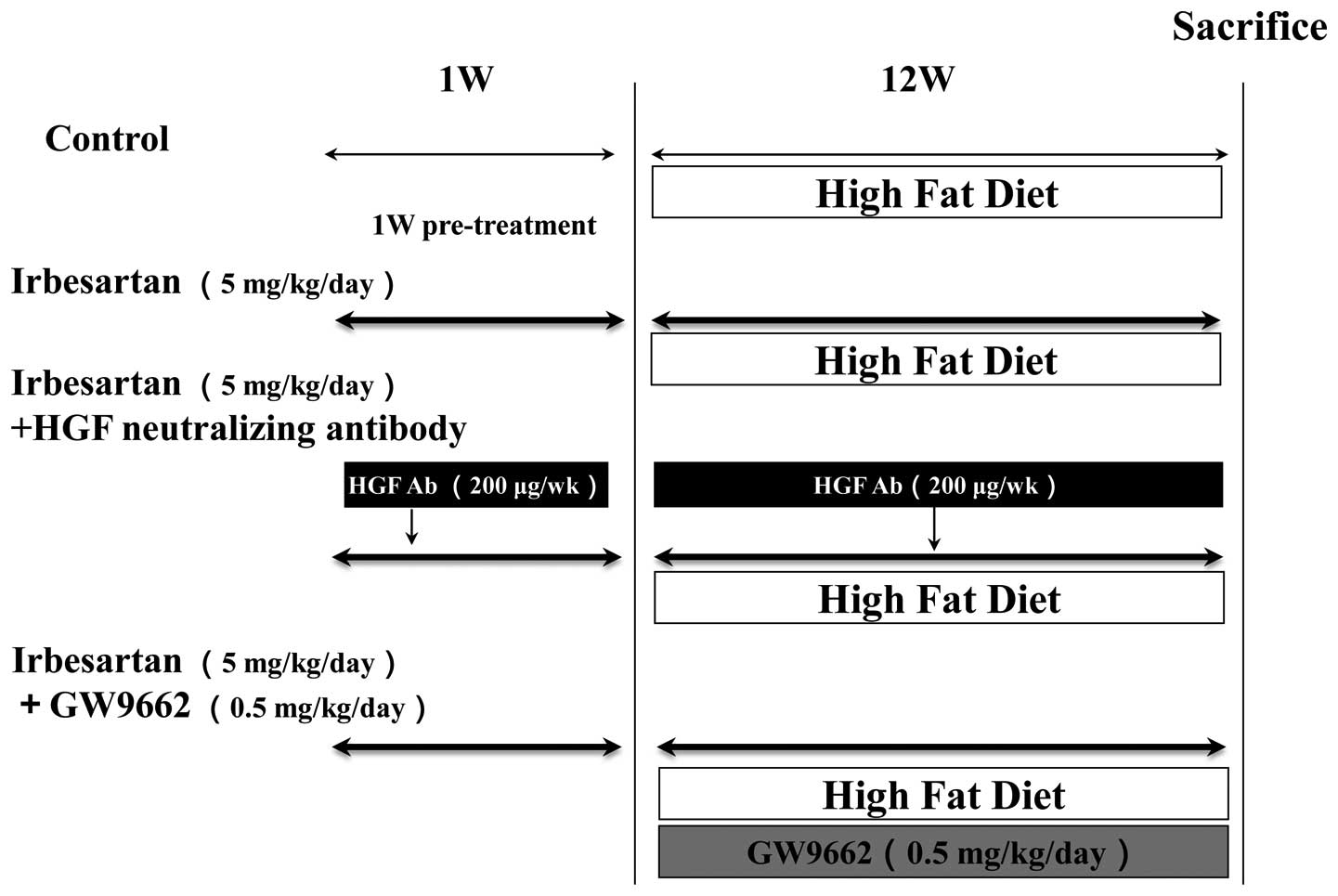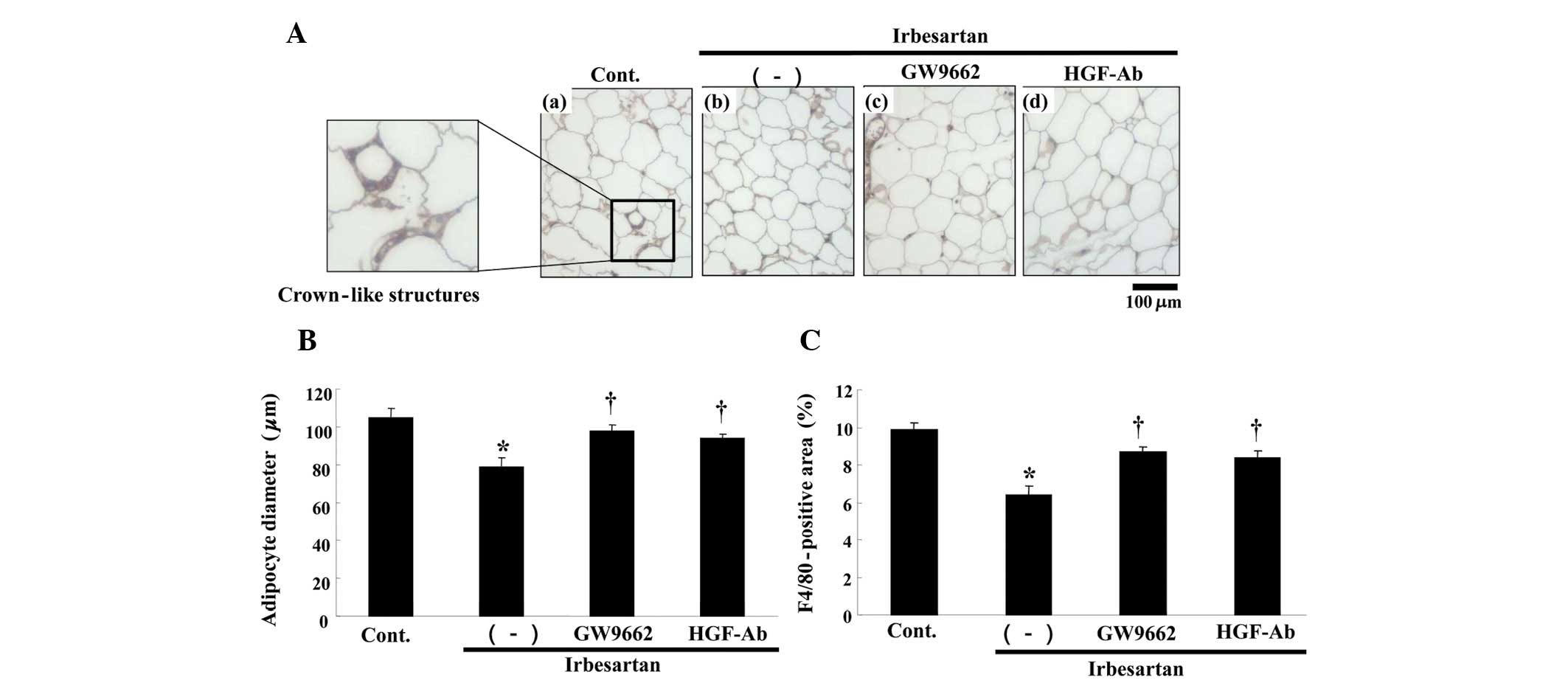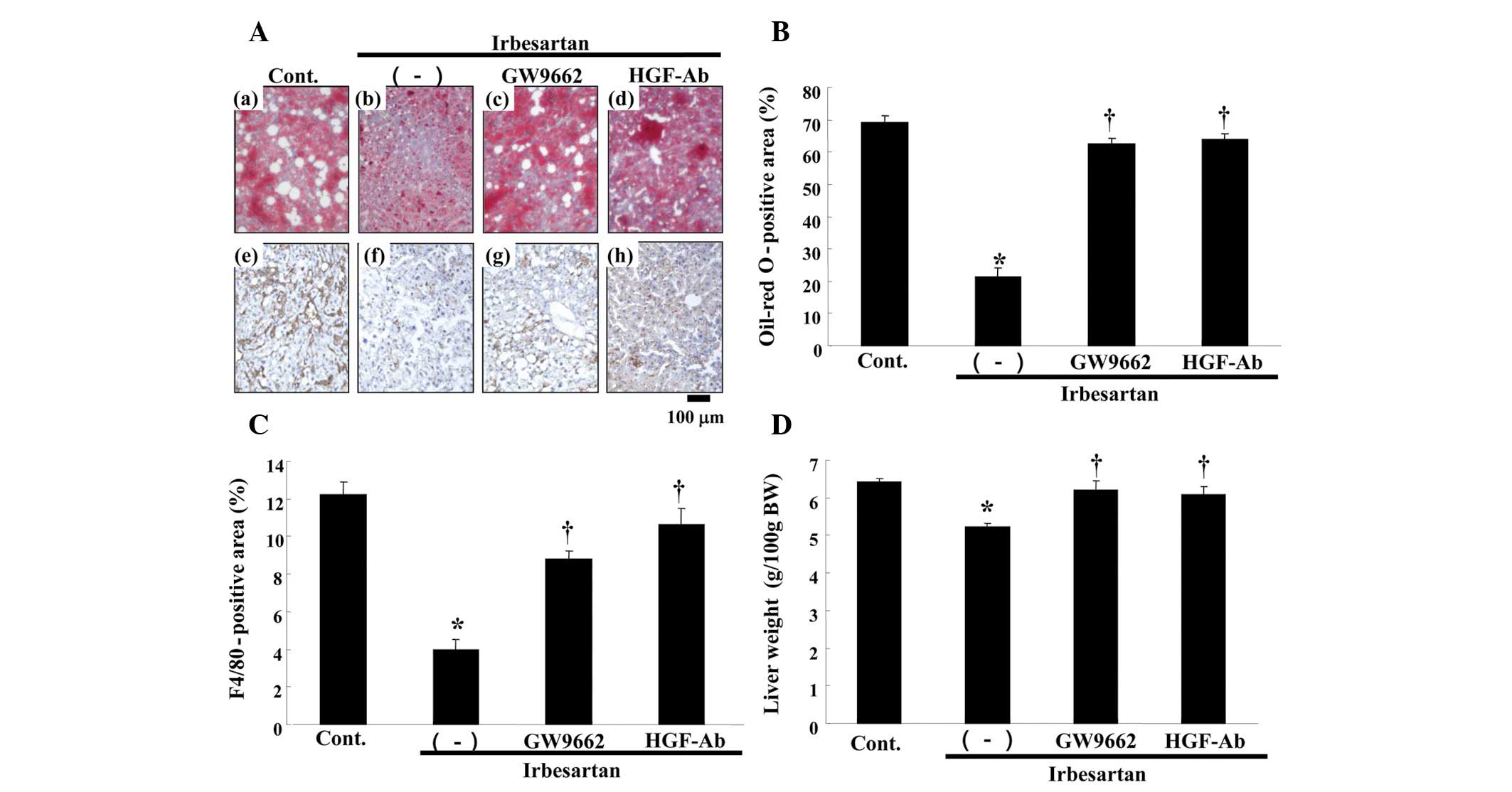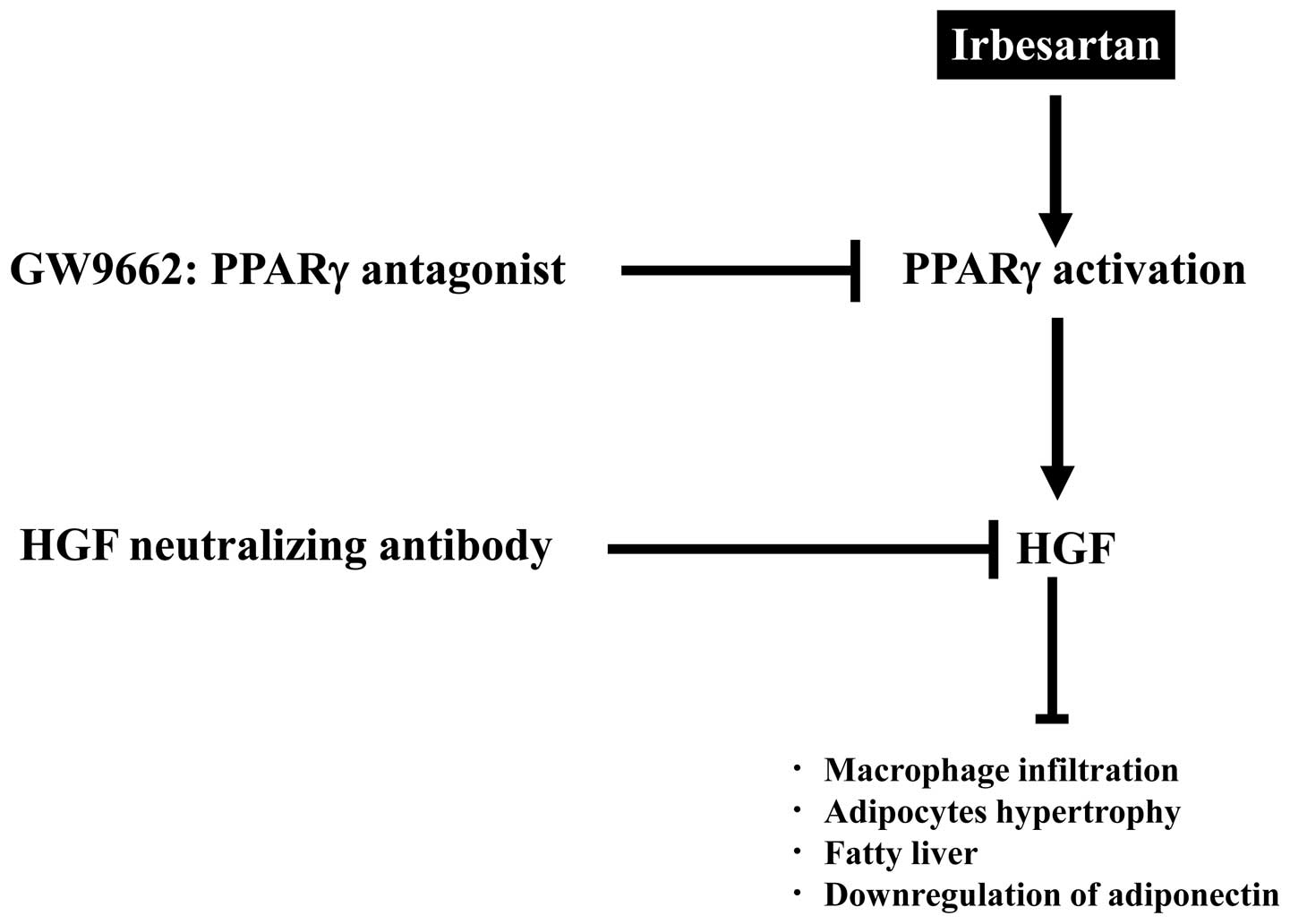|
1.
|
de Gasparo M, Catt KJ, Inagami T, Wright
JW and Unger T: International union of pharmacology. XXIII. The
angiotensin II receptors. Pharmacol Rev. 52:415–472.
2000.PubMed/NCBI
|
|
2.
|
Schupp M, Janke J, Clasen R, Unger T and
Kintscher U: Angiotensin type 1 receptor blockers induce peroxisome
proliferator-activated receptor-gamma activity. Circulation.
109:2054–2057. 2004. View Article : Google Scholar : PubMed/NCBI
|
|
3.
|
Lehmann JM, Moore LB, Smith-Oliver TA,
Wilkison WO, Willson TM and Kliewer SA: An antidiabetic
thiazolidinedione is a high affinity ligand for peroxisome
proliferator-activated receptor gamma (PPAR gamma). J Biol Chem.
270:12953–12956. 1995. View Article : Google Scholar : PubMed/NCBI
|
|
4.
|
Rosen ED and Spiegelman BM: PPARgamma: a
nuclear regulator of metabolism, differentiation, and cell growth.
J Biol Chem. 276:37731–37734. 2001. View Article : Google Scholar : PubMed/NCBI
|
|
5.
|
Picard F and Auwerx J: PPAR(gamma) and
glucose homeostasis. Annu Rev Nutr. 22:167–197. 2002. View Article : Google Scholar : PubMed/NCBI
|
|
6.
|
Benson SC, Pershadsingh HA, Ho CI,
Chittiboyina A, Desai P, Pravenec M, Qi N, Wang J, Avery MA and
Kurtz TW: Identification of telmisartan as a unique angiotensin II
receptor antagonist with selective PPARgamma-modulating activity.
Hypertension. 43:993–1002. 2004. View Article : Google Scholar : PubMed/NCBI
|
|
7.
|
Schupp M, Clemenz M, Gineste R, Witt H,
Janke J, Helleboid S, Hennuyer N, Ruiz P, Unger T, Staels B and
Kintscher U: Molecular characterization of new selective peroxisome
proliferator-activated receptor gamma modulators with angiotensin
receptor blocking activity. Diabetes. 54:3442–3452. 2005.
View Article : Google Scholar
|
|
8.
|
Parhofer KG, Münzel F and Krekler M:
Effect of the angiotensin receptor blocker irbesartan on metabolic
parameters in clinical practice: the DO-IT prospective
observational study. Cardiovasc Diabetol. 6:362007. View Article : Google Scholar : PubMed/NCBI
|
|
9.
|
Li Y, Wen X, Spataro BC, Hu K, Dai C and
Liu Y: Hepatocyte growth factor is a downstream effector that
mediates the antifibrotic action of peroxisome
proliferator-activated receptor-gamma agonists. J Am Soc Nephrol.
17:54–65. 2006. View Article : Google Scholar
|
|
10.
|
Kusunoki H, Taniyama Y, Azuma J, Iekushi
K, Sanada F, Otsu R, Iwabayashi M, Okayama K, Rakugi H and
Morishita R: Telmisartan exerts renoprotective actions via
peroxisome proliferator-activated receptor-γ/hepatocyte growth
factor pathway independent of angiotensin II type 1 receptor
blockade. Hypertension. 59:308–316. 2012.PubMed/NCBI
|
|
11.
|
Bieghs V, Rensen PC, Hofker MH and
Shiri-Sverdlov R: NASH and atherosclerosis are two aspects of a
shared disease: central role for macrophages. Atherosclerosis.
220:287–293. 2012. View Article : Google Scholar : PubMed/NCBI
|
|
12.
|
Janke J, Schupp M, Engeli S, Gorzelniak K,
Boschmann M, Sauma L, Nystrom FH, Jordan J, Luft FC and Sharma AM:
Angiotensin type 1 receptor antagonists induce human in-vitro
adipogenesis through peroxisome proliferator-activated
receptor-gamma activation. J Hypertens. 24:1809–1816. 2006.
View Article : Google Scholar
|
|
13.
|
Clasen R, Schupp M, Foryst-Ludwig A,
Sprang C, Clemenz M, Krikov M, Thöne-Reineke C, Unger T and
Kintscher U: PPARgamma-activating angiotensin type-1 receptor
blockers induce adiponectin. Hypertension. 46:137–143. 2005.
View Article : Google Scholar : PubMed/NCBI
|
|
14.
|
Nakamura T and Mizuno S: The discovery of
hepatocyte growth factor (HGF) and its significance for cell
biology, life sciences and clinical medicine. Proc Jpn Acad Ser B
Phys Biol Sci. 86:588–610. 2010. View Article : Google Scholar : PubMed/NCBI
|
|
15.
|
Choi SY, Kim D, Kang JH, Park MJ, Kim YS,
Lim SH, Kim CH and Lee HS: Nonalcoholic fatty liver disease as a
risk factor of cardiovascular disease: relation of non-alcoholic
fatty liver disease to carotid atherosclerosis. Korean J Hepatol.
14:77–88. 2008.(In Korean).
|
|
16.
|
Nakagami H, Osako MK, Takami Y, Hanayama
R, Koriyama H, Mori M, Hayashi H, Shimizu H and Morishita R:
Differential response of vascular hepatocyte growth factor
concentration and lipid accumulation between telmisartan and
losartan in ApoE-deficient mice. Mol Med Rep. 1:657–661. 2008.
|
|
17.
|
Kato J, Koda M, Kishina M, Tokunaga S,
Matono T, Sugihara T, Ueki M and Murawaki Y: Therapeutic effects of
angiotensin II type 1 receptor blocker, irbesartan, on
non-alcoholic steatohepatitis using FLS-ob/ob male mice. Int J Mol
Med. 30:107–113. 2012.PubMed/NCBI
|
|
18.
|
Rong X, Li Y, Ebihara K, Zhao M, Kusakabe
T, Tomita T, Murray M and Nakao K: Irbesartan treatment
up-regulates hepatic expression of PPARalpha and its target genes
in obese Koletsky (fa(k)/fa(k)) rats: a link to amelioration of
hypertriglyceridaemia. Br J Pharmacol. 160:1796–1807. 2010.
View Article : Google Scholar : PubMed/NCBI
|




















